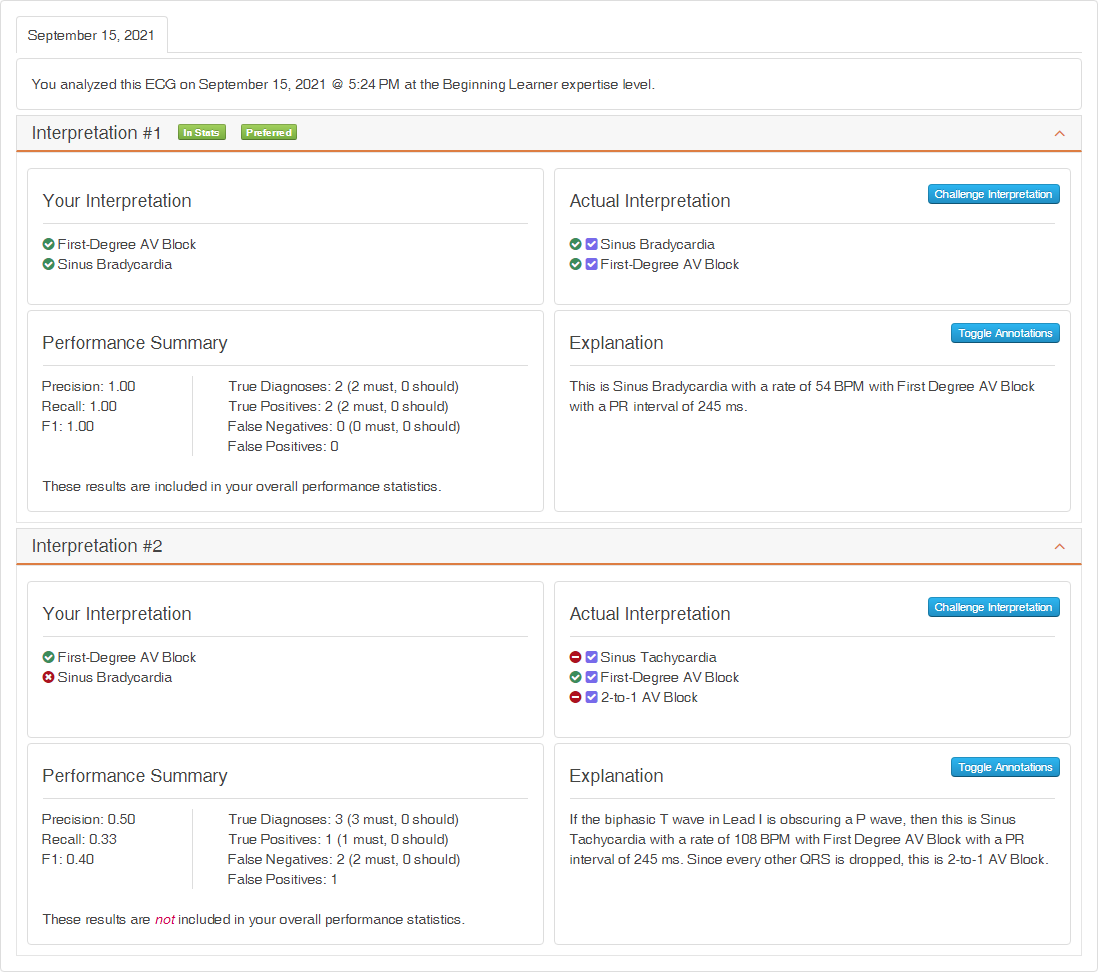Table of Contents
Multiple Interpretations
In some cases, it is impossible to determine a single definitive interpretation for a given ECG. To address this, the ECG Quiz provides specific provisions for managing multiple interpretations. User submissions are graded against all interpretations, ensuring a fair and comprehensive evaluation of diagnostic accuracy.
An Illustrative Example
Consider the following example. While at first glance, this looks like a straightforward example of Sinus Bradycardia (rate of 54 BPM) with First Degree AV Block (PR Interval of 245 ms). However, notice the biphasic nature of the T wave in Lead I, which could be masking a P wave. If one were to march the calipers set at a rate of 108 BPM, one would notice that a P wave could be hidden in the T wave. If this is the case, then this ECG demonstrates Sinus Tachycardia with First Degree AV Block and 2-to-1 AV Block.
At first glance, this ECG shows a straightforward case of Sinus Bradycardia (heart rate: 54 BPM) with First-Degree AV Block (PR interval: 245 ms).
However, closer inspection reveals a biphasic T wave in Lead I, which could be masking a P wave. Using calipers set to a heart rate of 108 BPM, one can identify that a P wave might be hidden within the T wave. If this is the case, the interpretation changes significantly, and the ECG would instead demonstrate Sinus Tachycardia (heart rate: 108 BPM), First-Degree AV Block, and 2-to-1 AV Block.
This example underscores the importance of thorough analysis and careful evaluation of ECG waveforms to ensure accurate diagnosis, particularly in complex cases. Continue reading below for detailed instructions on how to enter diagnoses for ECGs like this one. Properly entering diagnostic statements ensures accurate grading and reinforces key learning objectives.

Multiple ECG Interpretations
The ECG Quiz records each interpretation separately for ECGs with multiple possible interpretations. Among these, one is designated as the Preferred Interpretation. The simplest or most obvious interpretation is usually selected as the Preferred Interpretation.
For the example described above and shown in Figure 1, two interpretations would be created:
- Sinus Bradycardia with First-Degree AV Block (Preferred Interpretation)
- Sinus Tachycardia, First-Degree AV Block, and 2-to-1 AV Block
By prioritizing the simplest interpretation, the Preferred Interpretation serves as a baseline for users while still acknowledging the possibility of more complex diagnoses.
User's Interpretation
When entering diagnoses to support your interpretation, follow these principles:
- Select a Single Interpretation:
- Choose the interpretation you are most confident in and focus on entering only the diagnostic statements that support that interpretation.
- Avoid entering diagnoses for all possible interpretations that could apply to the ECG since this is not a differential diagnosis situation.
- Include All Supporting Diagnostic Statements:
- Ensure your submission includes all diagnostic statements relevant to your chosen interpretation.
- For example, if an ECG shows a run of Ventricular Tachycardia within Normal Sinus Rhythm, you must enter both Normal Sinus Rhythm and Ventricular Tachycardia to achieve the highest score.
For the example discussed above and shown in Figure 1:
- If you believe the T wave in Lead I obscures P waves, only enter Sinus Tachycardia, First-Degree AV Block, and 2-to-1 AV Block.
- If you do not think the T wave in Lead I obscures P waves, only enter Sinus Bradycardia and First-Degree AV Block.
Adhering to these guidelines will ensure that your submissions are precise, focused, and aligned with the expectations of the ECG Quiz grading system.
Grading and Performance Evaluation in the ECG Quiz
Your interpretation is graded against all interpretations created for the ECG. The following grading principles apply:
1. Best Performance Recorded:
- Your highest F1 score across all possible interpretations determines your performance.
- This ensures that your best effort is reflected in your statistics.
2. Preferred Interpretation Used for Ties:
- If your performance is identical across all interpretations, your grade is recorded based on the Preferred Interpretation for the ECG.
- This provides consistency in performance tracking and quiz results.
The ECG Quiz uses this grading approach to ensure fair evaluation while prioritizing your strongest diagnostic effort.
Notice
When multiple interpretations are present for an ECG in a public, shared, or organization quiz, the user's interpretation is always graded against the Preferred Interpretation.
Results Display and Interpretation Grading
The results display includes the user's performance graded against all interpretations entered for the ECG. In addition, the “Preferred Interpretation” and the diagnosis stored in your overall statistics or quiz results are indicated with badges on the results page.
The Results Page provides a comprehensive breakdown of your performance, graded against all interpretations entered for the ECG. Key features include:
- Grading Against All Interpretations:
- Your submission is graded against each annotated interpretation for the ECG.
- Results are presented for each annotated interpretation.
- Badges for Key Indicators:
- The Preferred Interpretation is marked with the
 badge on the results page.
badge on the results page. - The results included in your overall statistics or quiz results are indicated with the
 badge for easy identification.
badge for easy identification.
- Challenge Option:
- If you disagree with our interpretations, you can challenge our interpretations for review.
In the example discussed above and shown in Figure 1, the results shown in Figure 2 assume the user does not think that the T waves are obscuring P waves. By providing detailed feedback and transparent grading, the results page ensures a clear understanding of your performance and an opportunity to refine your diagnostic skills.
